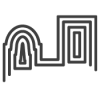Simien Mountains
Northern Circuit
Introduction to Simien National Park
Referred to as ‘The Roof of Africa’, the Simien Mountains in northern Ethiopia form a landscape so vast and spectacular that it rivals the Grand Canyon in Colorado.
Comprising high plateaus and deep, rugged gorges, carved by erosion over millions of years, the terrain rises to form towering cliffs that plummet – some as much as 1,500 meters, into vast valleys. The highest peak, Ras Dashen, towers a staggering 4,620 meters above sea level. On cloudless days the views appear to continue on forever, with one chain of mountains giving rise to the next. When soaking up these incredible vistas it is easy to grasp that 70 per cent of Africa’s mountains are located in Ethiopia.
Aside from spectacular views, the Simien Mountains are home to endemic species of flora, fauna and avifauna that have captivated the interest of nature and wildlife enthusiasts from around the world. Listed by UNESCO as a World Heritage Site of ‘Outstanding Universal Value’, the Simien Mountains National Park, which was established in 1969, is protected by the National Protected Areas legislation. The park also falls within the area listed as the Eastern Afromontane biodiversity hotspot, making it one of 35 major global conservation hotspots. According to UNESCO: “The park is of global significance for biodiversity conservation because it is home to globally threated species, including the iconic Walia ibex – a wild mountain goat found nowhere else on earth, the Gelada baboon and the Ethiopian wolf”.
With a total area of 190km², the Simien Mountains National Park’s varied habitats are home to 22 large and 13 small mammal species. The park also offers a rich birding experience, with about 180 recorded species, of which 16 are regional endemics. The lammergeyer, a large vulture, is often sighted here.
Three distinct vegetation belts occur in the park, each belt featuring interesting flora, including 57 tree species and a wealth of herbaceous plants. The giant Lobelia, which occurs in the grasslands above 3,700 meters above sea level, measures up to 10 meters in height. This fascinating plant grows for up to two decades before flowering for the first time, and then dying.
The park’s admin office/entrance is located at Debark, a market village that lies about 110km north of Gondar, roughly a two-hour’s drive from Gondar.
Travel Tip
When in Simien Mountains
Key Attractions
BIODIVERSITY: FLORA, FAUNA & AVIFAUNA
Simien Mountain National Park is in a biodiversity hotspot with diverse plants and animals.
Three vegetation zones vary by altitude: Montane forest, Sub-Afroalpine and Afroalpine.
Some species are endemic, such as Festuca gilbertiana, Rosularia simensis and Dianthus longiglumi.
Endemic animals include Simien Wolf, Walia ibex and Gelada baboon.
Other mammals and birds are also found, some regionally endemic.
WALIA IBEX (Capra walie)
The Walia ibex, endemic to the Simien Mountains, is one of the most endangered mammal species on earth. It is estimated that as few as 500 animals still exist.
These giant mountain goats inhabit the high cliffs in the Simien Mountains, at an elevation of around 3,500 meters above sea level. They are most active during the early mornings and late evenings. On sunny days they will try to find some shade to shelter from the sharp sun.
The most distinguishing feature of these giant mountain goats is their horns. Males have massive, backward-curving horns that reach up to 110 cm in length. The females’ horns are much shorter and thinner. The males also have impressive beards, which turn black when they are older.
SIMIEN FOX OR ETHIOPIAN WOLF (Canis simensis)
With fewer than 440 of these beautiful mammals still in existence, the tawny red Simien Wolf is the rarest canid on earth. Endemic to Ethiopia, they are found mostly in afro-alpine mountain habitats, at altitudes above 3,600 meters above sea level. A small population – estimated at a quarter of the total population, inhabits the Simien Mountains; with a larger one being found in the Bale Mountain National Park, in southern Ethiopia. The species was registered as endangered in the Red Data Book of the World Conservation Union (IUCN) in 1990.
The Ethiopian Wolf, unlike other wolf species, is a solitary hunter. They feed on rodents and other small animals. When they are not hunting they move in packs of up to 13 individuals.
GELADA BABOON (Theropithecus gelada)
The Gelada baboon is also known as the “Bleeding-heart monkey” and “Lion baboon”. Endemic to Ethiopia, they can be found on most of the highland plateaus of the Simien Mountains. These fascinating animals are essentially in a genus of their own, as they cannot truly be classified as either baboons or monkeys. Moving in herds of 100 to 200 individuals, these docile grazers are the last existing species of grass-eating primate. You may wonder why they are also known as the Bleeding-heart monkey. Geladas are easily recognizable by the bare patches of skin on their chests. During mating season these patches, in females, turn a remarkable bright crimson.
Travel Tip

The park was added to the UNESCO World Heritage Site list in 1978 as a site of „Outstanding Universal Value“.
With a total area of 190km², the Simien Mountains boast 57 tree species, a wealth of herbaceous plants, 22 large and 13 small mammals and about 180 recorded bird species.
Walia ibex, Ethiopian wolf, Menelik’s Bushbuck and the Gelada baboon are among the list of endemic species.
When in Simien Mountains
Key Attractions
BIODIVERSITY: FLORA, FAUNA & AVIFAUNA
Simien Mountain National Park is in a biodiversity hotspot with diverse plants and animals.
Three vegetation zones vary by altitude: Montane forest, Sub-Afroalpine and Afroalpine.
Some species are endemic, such as Festuca gilbertiana, Rosularia simensis and Dianthus longiglumi.
Endemic animals include Simien Wolf, Walia ibex and Gelada baboon.
Other mammals and birds are also found, some regionally endemic.
WALIA IBEX (Capra walie)
The Walia ibex, endemic to the Simien Mountains, is one of the most endangered mammal species on earth. It is estimated that as few as 500 animals still exist.
These giant mountain goats inhabit the high cliffs in the Simien Mountains, at an elevation of around 3,500 meters above sea level. They are most active during the early mornings and late evenings. On sunny days they will try to find some shade to shelter from the sharp sun.
The most distinguishing feature of these giant mountain goats is their horns. Males have massive, backward-curving horns that reach up to 110 cm in length. The females’ horns are much shorter and thinner. The males also have impressive beards, which turn black when they are older.
SIMIEN FOX OR ETHIOPIAN WOLF (Canis simensis)
With fewer than 440 of these beautiful mammals still in existence, the tawny red Simien Wolf is the rarest canid on earth. Endemic to Ethiopia, they are found mostly in afro-alpine mountain habitats, at altitudes above 3,600 meters above sea level. A small population – estimated at a quarter of the total population, inhabits the Simien Mountains; with a larger one being found in the Bale Mountain National Park, in southern Ethiopia. The species was registered as endangered in the Red Data Book of the World Conservation Union (IUCN) in 1990.
The Ethiopian Wolf, unlike other wolf species, is a solitary hunter. They feed on rodents and other small animals. When they are not hunting they move in packs of up to 13 individuals.
GELADA BABOON (Theropithecus gelada)
The Gelada baboon is also known as the “Bleeding-heart monkey” and “Lion baboon”. Endemic to Ethiopia, they can be found on most of the highland plateaus of the Simien Mountains. These fascinating animals are essentially in a genus of their own, as they cannot truly be classified as either baboons or monkeys. Moving in herds of 100 to 200 individuals, these docile grazers are the last existing species of grass-eating primate. You may wonder why they are also known as the Bleeding-heart monkey. Geladas are easily recognizable by the bare patches of skin on their chests. During mating season these patches, in females, turn a remarkable bright crimson.
Where to say
Accommodations
Limalimo Lodge
Limalimo Lodge is a haven of understated luxury, designed to blend in with the environment. This boutique lodge has 14 bedrooms, all with ensuite bathrooms.
In keeping with their ethos of sustainability, the lodge was built using green technologies. Eco-friendly by nature, Limalimo‘s design was inspired by local building techniques, using sustainable sources.
The spacious terrace, perfect for meals or sundowners, offers breathtaking panoramic views of the Simien Mountain National Park and the layers of mountains beyond. Facilities include a bar and restaurant, known for its excellent cuisine. All stays at Limalimo are on a full board basis, and the restaurant offers set menus with international dishes. Traditional injera is always available on request. No internet facilities are available and guests are invited to take a break from technology and soak up the natural environment.
Simien Mountain Lodge
Offering all the charm you’d expect from a mountain lodge, Simien Lodge offers warm hospitality in a breathtaking setting. The lodge has 26 comfortable rooms (24 twin and 2 double), located in round thatched stone rondavels or “tukuls”, as they are called locally. The Ethiopian décor is authentic and appealing. All the rooms have ensuite bathrooms, with showers and not baths, to conserve water during the dry months. The water is solar-heated, with electrical backup. The rooms are insulated (ceilings, floors and walls). The cozy bar features a large central fireplace and comfortable furnishing, for relaxed evenings with friends and family. The restaurant also features a generous fireplace and authentic Ethiopian art. A set menu is offered at dinner, with a selection of dishes skillfully prepared by the Head Chef. An a la Carte menu with a variety of international and local dishes, is available throughout the day. Wi-Fi is available in the main area, but not in the rooms.











